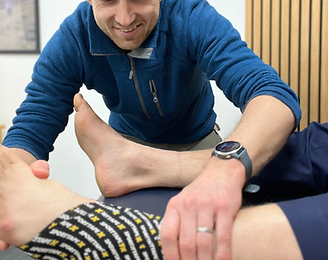
Physiotherapy
Highest quality
Treatments
Specialist hands on techniques alongside innovative medical technology are personally selected based on you, your injury and what you are comfortable with.
All treatments are clinically reasoned from 15 years experience and evaluation of best current evidence.
Whichever specialist treatments are required they will always be included in your sessions at no additional charge.




Sports Injuries
Back Pain
Post Surgical Rehabilitation
Arthritis
Knee Pain
Growing Pains
Sciatica
Frozen Shoulder
Repetitive Strain
Nerve Pain

Manual Therapies
Expert hands on therapy techniques can help with a number of different injuries.
Mobilisation, manipulation and massage are all examples of manual therapy. Pressure is applied over the targeted area to address pain or restrictions in movement. This pressure is graded from very light pressure to much more firm techniques depending on the injury.
Exercise Prescription
In my opinion exercise is fundamental to all physiotherapy treatments. The key is to working together to achieve the right areas to target, technique and frequency.
The exercise area within the treatment studio ensures I can accurately assess and prescribe the right exercise.
All patients receive a individualised program sent to them directly including interactive videos.


Muscle Stimulation
When you want to contract a muscle, your brain sends electrical pulses to your motor nerves in order to force a contraction. Electrostimulation (EMS) is a technique that precisely mimics these processes, with the stimulator device sending the electrical pulses.
Used when we feel that the link between muscle, nerves and brain has been disrupted which happens commonly following even the most straight forward of minor muscle strains. This fantastic equipment can be used all across the body by all ages.
Fascial Release
Fascia is a layer of connective tissue that forms part of our musculoskeletal system. It can restrict muscle, ligament and tendon function. It reacts differently than those tissue so we use different techniques in order to treat it. Most specifically either cupping therapy or instrument assisted soft tissue mobilisation.


Taping Techniques
Taping is utilised in many different scenarios due to its ease of use and versatility. Tape works by a few key principles. It creates a lifting motion on the skin that creates space between the top layer of the skin and underlying tissues. Reducing pressure on pain receptors and encouraging lymphatic flow. It also provides feedback on positioning of the area taped and can reduce discomfort by helping to desensitise the injured structures.
Gait Analysis
Gait (walking motion) analysis is about finding out how your injury is affecting your mobility. By studying your walking pattern I am able to tailor the treatment approach to you and utilise video to demonstrate to you the insufficiencies
Gait analysis is as important for elite runners as it is all of us who are able to walk.

Isometric Testing

Smart testing system allows me to assess your strength and range of motion (ROM) in a large range of tests across every major joint in the body.
We then use this data at various stages of your recovery to help track your progress and objectively monitor differences between injured and non injured tissues.
Another example of a treatment commonly used with athletes but has a much wider application to everyone regardless of age or activity level.
Dry Needling
Trigger-point dry needling is a procedure where a fine needle is inserted into the skin and muscle. It targets myofascial trigger points (MTrPs) - hyper irritable spots palpable as nodules in the taut bands of skeletal muscles.
Trigger point dry needling can be performed at either superficial or deep tissue levels. I will only utilise this treatment if you are completely comfortable with it.

Shockwave Therapy
Radial shockwave therapy is an electrotherapy used to treat chronic injuries most specifically tendon issues. It produces acoustic pressure waves to create a healing response and remodel the tissue.
Normally between 4-6 sessions of shockwave therapy are needed at weekly intervals.

